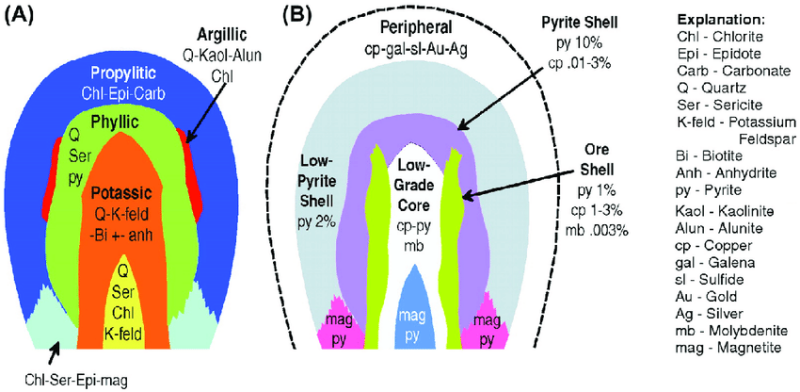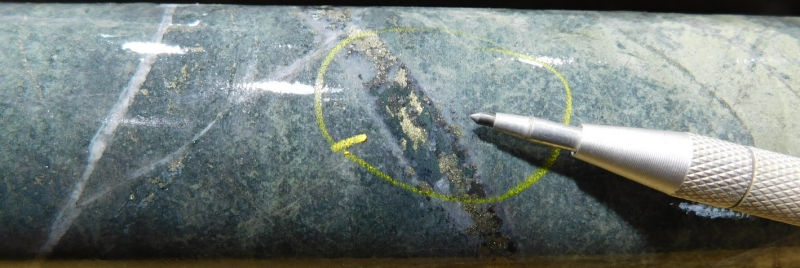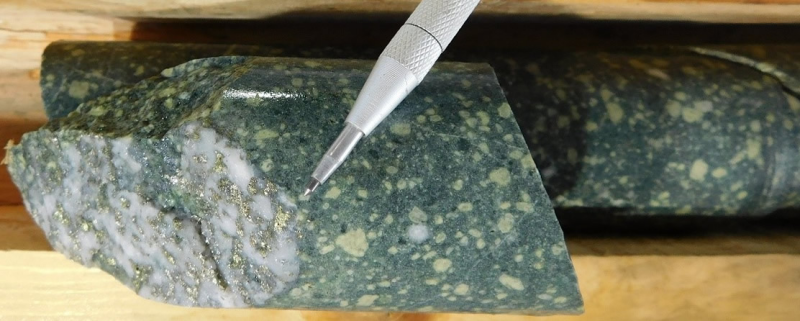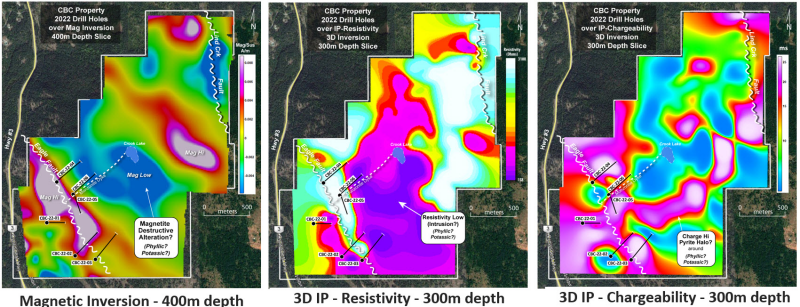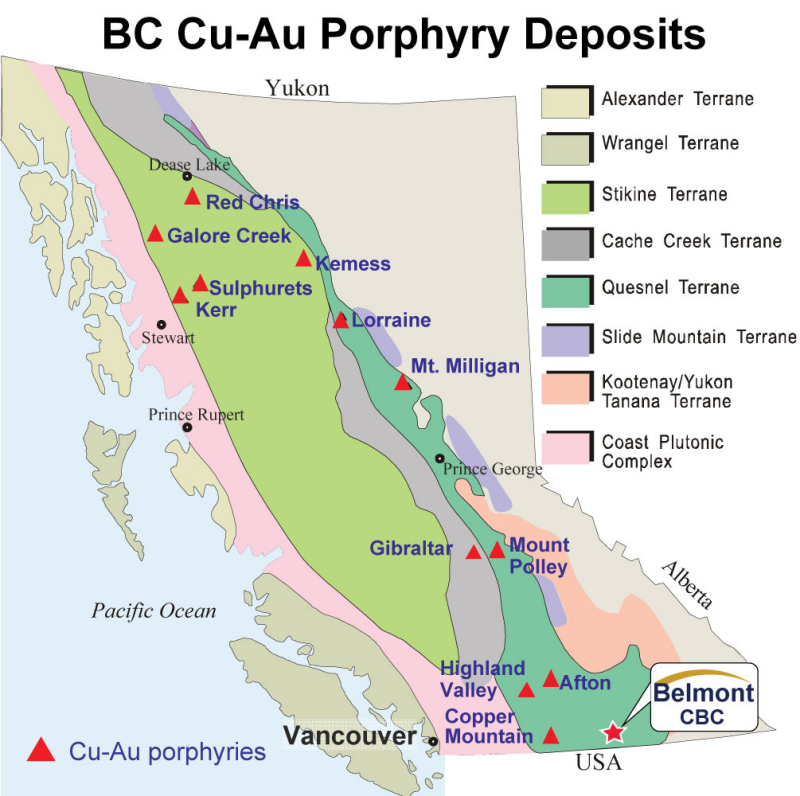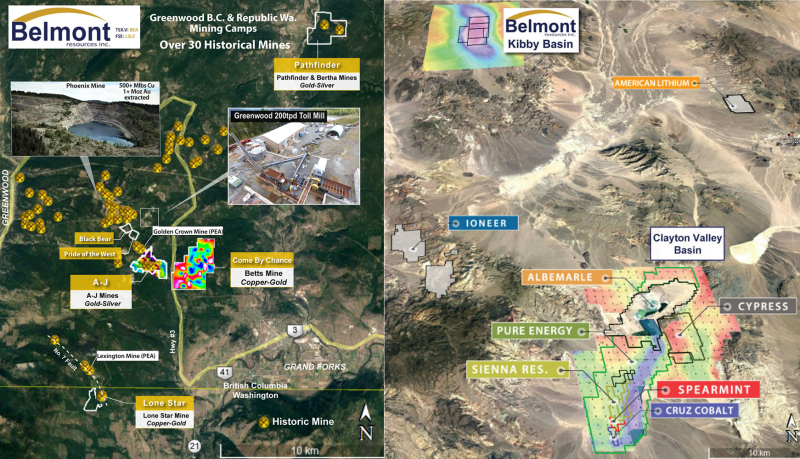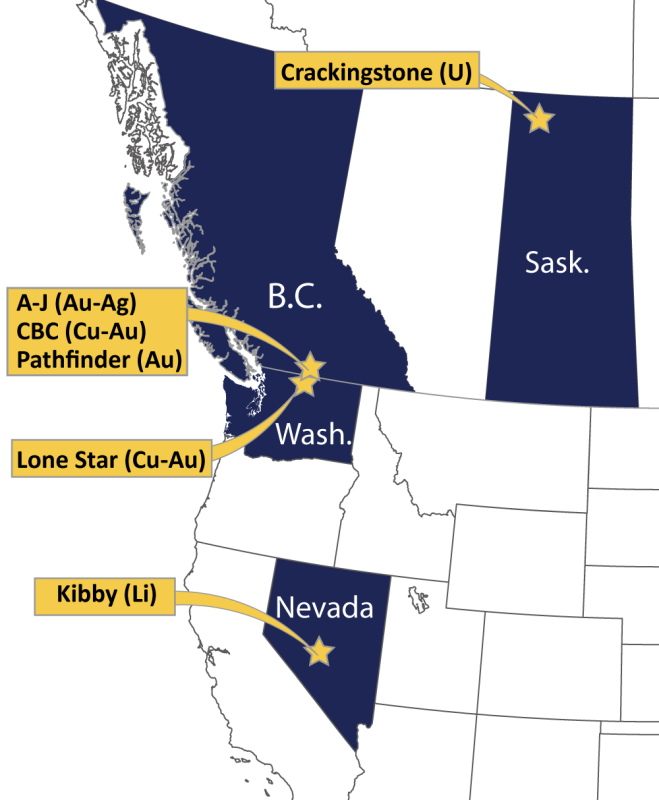Belmont Identifies New Porphyry Mineralization With First Drill Program at CBC Project, British Columbia
(TheNewswire)


Belmont Identifies New Porphyry Mineralization With First Drill Program
at CBC Project, British Columbia
“The alteration and mineralization observed in drill core from all six holes, suggests that we have potentially drilled the periphery of a new porphyry copper-gold system in British Columbia.” comments George Sookochoff, Chief Executive Officer. “We are just beginning to unlock the untapped potential of the CBC porphyry project.
Highlights
-
The CBC Property is situated on the Quesnel Terrane, a geological formation which hosts several large copper-gold porphyry deposits such as Copper Mountain, Afton, Highland Valley and Mount Milligan.
-
The 2,304 meter drill program confirms porphyry style alteration, veining and mineralization over an initial area measuring 1,300 meters by 900 meters.
-
Extensive Propylitic (chlorite, epidote, albite and carbonate) alteration encountered in all six drill holes. Common to most porphyry deposit types, large propylitic alteration forms as halos to the core of porphyry deposits.
-
Extensive pyrite mineralization (up to 20%). Pyrite halos are another important vector which helps in locating possible porphyry core.
-
Drill holes CBC-22-01, 02, 03, and 05 were dominated by propylitic alteration with localized skarn alteration which is distal to a possible heat source like those known elsewhere to host porphyry-style mineralization.
(Cross section of a porphyry copper deposit showing idealized alteration zoning (after Lowell and Guilbert, 1970).
-
Skarn assemblages variably including epidote-magnetite-garnet-chlorite-hematite-carbonate-quartz with pyrite. Copper skarn deposits occur near many porphyry copper host intrusions that intruded carbonate-bearing units (Einaudi and others, 1981), and skarn mineral zoning patterns may be useful in the targeting of a potentially associated porphyry copper deposit (Meinert and others, 2005).
-
Drill holes CBC-22-04 and 06 showed increasing pyrite-pyrrhotite mineralization along with quartz and sericite and other clay mineral alteration. Elevated molybdenum was also noted in these holes. This indicates a slight increase in hydrothermal fluid temperature, with an accompanying transition from the propylitic and localized skarn alteration seen elsewhere to a weak phyllic alteration here
-
Geophysics provides further vectors pointing towards a possible porphyry core.
Vancouver, B.C. Canada – TheNewswire - July 14, 2022; Belmont Resources Inc. (“Belmont”), (or the “Company”), (TSXV:BEA); (FSE:L3L2) is pleased to report the Phase I 2022 drill program at its 100% owned Cu-Au Come By Chance (CBC) Property located in southern B.C. was successful in further delineating a potential copper gold porphyry system.
The phase one program comprised of 6 diamond drill holes totaling 2,304 meters. The program targeted areas with magnetic, chargeability and resistivity anomalies within the Betts, Lady M and Iron Chief targets within the CBC property, with targets refined by known surface showings when available.
Drill Hole Summaries
CBC-22-01
This drillhole targeted a magnetic high-to-low transition and a chargeability high and resistivity low. The dominant lithology was a fine-grained tuffaceous volcanic with the alteration dominated by a propylitic assemblage with pervasive chloritization and patchy epidote bands. Mineralization can be generalized as minor but ubiquitous pyritic stringers and disseminations with uncommon chalcopyrite in quartz-pyrite veins. The most promising mineralization was from approximately 106–120 m and included several loose bands and veins of coarse pyrite-magnetite-chalcopyrite associated with quartz veins and local flooded silica. (Fig. 3).
Figure 2. Pyrite-magnetite-chalcopyrite quartz veins (CBC-22-01; 113.8 m).
Figure 3. Sooty pyrite replacements within vuggy silica-carbonate and bleached wall rock (CBC-22-01; 186.85 m).
CBC-22-02
This drillhole targeted near a linear magnetic trend and into a chargeability high and resistivity high and collared south of the historic Betts workings. The dominant lithology was a fine-grained tuffaceous volcanic, interrupted by minor augite-phyric flows and locally clast-bearing volcanics. The alteration was dominated by a propylitic assemblage with pervasive chloritization and patchy epidote bands. Mineralization was not as strong as in CBC-22-01
Figure 4. Bleached pyritic veining and breccia (CBC-22-02; 74.18 m)
Figure 5. Quartz-pyrite-chalcopyrite vein (CBC-22-02; 197.93 m).
Figure 6. Pyrite and minor magnetite band (CBC-22-02; 436.87 m).
CBC-22-03
This drillhole targeted a magnetic low and chargeability high and collared southeast of the historic Betts workings. The dominant lithologies were fine-grained tuffs and limestones, although the tuffs were clast-bearing over larger intervals and with larger clasts than in the previous two drillholes. The limestones are locally strongly altered over up to 19 meters to skarn assemblages variably including epidote-magnetite-garnet-chlorite-hematite-carbonate-quartz with pyrite and trace chalcopyrite.
Figure 7. Pyritic silicified margin of skarning within limestone (CBC-22-03; 118.2 m).
Figure 8. Skarn alteration with pyrite and trace chalcopyrite (CBC-22-03; 136.5 m).
Figure 9. Quartz-pyrite-chalcopyrite vein (CBC-22-03; 413.5 m).
CBC-22-04
This drillhole targeted magnetic and resistivity lows and a chargeability high, and a Au soil anomaly. The tuffaceous rocks here are relatively texturally variable and overall relatively clastic and fragmental, including multiple intervals of plagioclase-phyric crystal tuffs which are ruled out as an intrusive unit based on their unaltered contacts and occasional interbedding with other volcanic units. The pervasive background chloritization and patchy epidote is locally bleached near intrusive contacts and shears, as well as the common quartz-carbonate-clay brecciation fills and flooding. These quartz-carbonate-clay zones can exceed 20 m in length and are accompanied by pyrrhotite-pyrite disseminations and breccia fills with trace chalcopyrite, locally exceeding 10–20% pyrite.
Figure 10. Quartz-carbonate with high pyrrhotite content, lesser pyrite and trace chalcopyrite (CBC-22-04; 13.15 m).
Figure 11. Pyritic quartz-carbonate breccia (CBC-22-04; 379.85 m).
CBC-22-05
View CBC-22-05 Drill Section
This drillhole targeted a NNW-trending magnetic anomaly and a mapped NE-trending monzonitic dike, as well as trending towards the historic Iron Chief workings. Lithologies are mostly variable crystal-rich and fragmental tuffs with minor limestone. Propylitic alteration includes pervasive chloritization and patchy epidote within volcanics, and weak to moderate chlorite-epidote within intrusives; near intrusive contacts or shears, moderate to strong bleaching can occur. Aside from a 9 m interval at top of hole containing similar sulfidic quartz-carbonate-clay breccias to those in CBC-22-04, mineralization is overall similar to CBC-22-01 and -02.
Figure 12. Quartz-pyrite-magnetite-chalcopyrite-chlorite vein (CBC-22-05; 289.9 m).
Figure 13. Exposed quartz-pyrite-chalcopyrite veinlet within plagioclase-phyric tuff (CBC-22-05; 229.59 m).
Figure 14. Quartz-pyrite-chalcopyrite vein with bladed hematite and bleached selvage (CBC-22-05; 327.75 m).
CBC-22-06
This drillhole targeted the same magnetic and resistivity lows and a chargeability high as CBC-22-04, but from the CBC-22-05 pad to the southeast of CBC-22-04. The dominant lithology was again tuffaceous volcanics and subordinate limestone. Other lithologies include 39 m of relatively augite-rich magnetic diorite (seemingly distinct from the magnetite diorite of earlier holes), and a fine-grained crystal tuff or volcanic sandstone with fine depositional bedding preserved (26 m). Lithological complexity in the mixed volcanics generally increased down-hole. Propylitic alteration is dominantly chlorite and epidote with local bleaching near some shears and brecciation, and the diorite contains broad patches of weak to moderate bleaching and sericitization. The best mineralization resembled the breccia-related pyrrhotite-pyrite from CBC-22-04, although here is relatively pyrite-rich with less pyrrhotite and chalcopyrite.
Figure 15. Molybdenite and pyrite within quartz-carbonate breccia (CBC-22-06; 155.86 m).
Figure 16. Rhodochrosite and pyrite within quartz-carbonate breccia (CBC-22-06; 149.3 m).
Figure 17. Colloform pyrite within quartz-carbonate breccia (CBC-22-06; 220.5 m).
Systematic modeling of 2010-11 geophysical data has highlighted a total magnetic intensity, apparent conductivity and resistivity features of interest including a coincident magnetic low to high transition interpreted to represent magnetite destruction, a resistivity low reflecting alteration or a buried intrusion and an apparent conductivity high which may represent the presence of sulphide minerals associated with alteration or mineralization.These geophysical features together are considered a high priority anomaly and potential new drill targets.
Drilling Results
Drilling in the outer propylitic alteration zone of the CBC property returned minimal copper grades, however this is not uncommon with copper-gold porphyries where copper-gold mineralization occurs primarily within the potassic core and overlying phyllic zone with intensity of copper grade and alteration intensity decreasing outwards.
Summary
The CBC Phase I drill program was very important in that the results further support a copper-gold-porphyry model.
-
By intercepting significant intervals of propylitic alteration it shows us where we may be in the various zonations of a copper porphyry system ie. Propylitic, Phyllic or Potassic.
-
Also significant amounts of chlorite, epidote and carbonates were associated with the Propylitic alteration which is also very important for confirming the position in the porphyry zonations.
-
An abundance of pyrite rich zones were intercepted which is common to copper porphyries. This fact accounted for the chargeability highs in the IP survey. We can also see from the IP chargeability results there is a charge-hi anomaly encircling the center of the property which may possibly be a pyrite halo around a porphyry core. Drill hole CBC 22-04 intercepted upto 20% pyrite which indicates that hole may be close to Phyllic zone of the system.
-
Elevated molybdenum was also noted in these holes. This indicates a slight increase in hydrothermal fluid temperature, with an accompanying transition from the propylitic and localized skarn alteration seen elsewhere to a weak phyllic alteration here.
-
Localized skarn alteration which is distal to a possible heat source like those known elsewhere to host porphyry-style mineralization.
-
Copper grades were consistently very low (.01% - 0.65%) which initially was disappointing. But once we understood that we were drilling in the Propylitic alteration zone it became apparent that the low grades in this area were normal. Copper and gold mineralization is typically associated mainly with the Potassic alteration zone of the porphyry system with the peripheral Propylitic alteration zone being copper poor.
From the original geological mapping, geophysical survey and now the first drilling we have gained a considerable amount of knowledge and a much better understanding of the CBC project. We will continue to thoroughly review and 3D model all the data and begin selecting new targets for a Phase II drill program in late fall of 2022.
Phase II Drill Program
Belmont is incorporating the drill results with 2021 geophysical data along with more detailed mapping to assist in vectoring toward the core of the porphyry system. Drilling is planned for late fall.
The CBC property is close to infrastructure (10 minutes from downtown Grand Forks, B.C.) and is accessible all year round. Belmont has a 5 year drilling permit of the CBC property.
About the Come By Chance Project
The CBC Property is situated on the Quesnel Terrane, a geological formation which hosts several large copper-gold porphyry deposits such as Copper Mountain, Afton, Highland Valley and Mount Milligan.
The property is situated in the Greenwood mining camp, considered to be one of the highest concentrated areas of past producing mines in North America
Although the Phoenix mine was the major producer, some of the smaller mines were also productive from a number of different types of deposits. From 1900 to 1975 production from these 26 principal mines was over 600 million pounds of copper and 1.4 million ounces of gold (Church, 1986).
The property contains mineralized skarns and epithermal zones, which are potentially associated with a concealed porphyry intrusive of copper/gold mineralization.
About Belmont Resources
Belmont Resources has assembled a portfolio of highly prospective copper-gold-lithium & uranium projects located in British Columbia, Saskatchewan, Washington and Nevada States. Its holdings include the Come By Chance (CBC), Athelstan-Jackpot (AJ) and Pathfinder situated in the prolific Greenwood mining camp in southern British Columbia. The Crackingstone Uranium project in the uranium rich Athabaska Basin of northern Saskatchewan. The Lone Star copper-gold mine in the mineral rich Republic mining camp of north central Washington State. The Kibby Basin Lithium project located 60 kilometers north of the lithium rich Clayton Valley Basin.
The Belmont project portfolio:
-
Athelstan-Jackpot, B.C. – * Gold-Silver mines
-
Come By Chance, B.C. – * Copper-Gold mine
-
Lone Star, Washington – * Copper-Gold mine
-
Pathfinder, B.C. – * Gold–Silver mines
-
Kibby Basin, Nevada – Lithium
-
Crackingstone, Sask. – Uranium
* past producing mine
NI 43-101 Disclosure:
The technical information in this news release has been prepared in accordance with Canadian regulatory requirements as set out in National Instrument 43-101 and has been reviewed and approved by Laurence Sookochoff, P.Eng. Mr. Sookochoff is a Director of Belmont Resources Inc.
ON BEHALF OF THE BOARD OF DIRECTORS
“George Sookochoff”
George Sookochoff, CEO/President
Ph: 604-505-4061
Email: george@belmontresources.com
Website: www.BelmontResources.com
We seek safe harbor. Neither TSX Venture Exchange nor its Regulation Services Provider (as that term is defined in the policies of the TSX Venture Exchange) accepts responsibility for the adequacy or accuracy of this release. The TSX Venture Exchange has not approved nor disapproved of the information contained herein.
Copyright (c) 2022 TheNewswire - All rights reserved.
